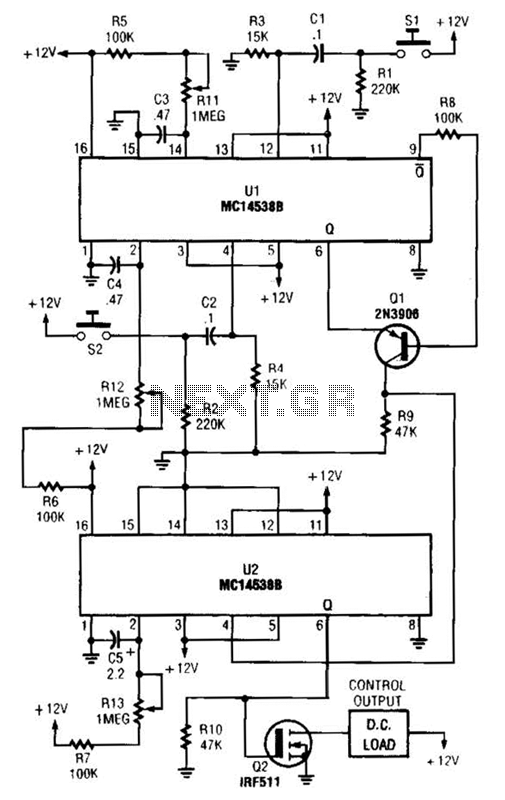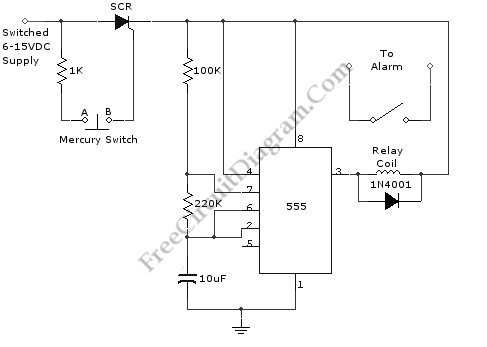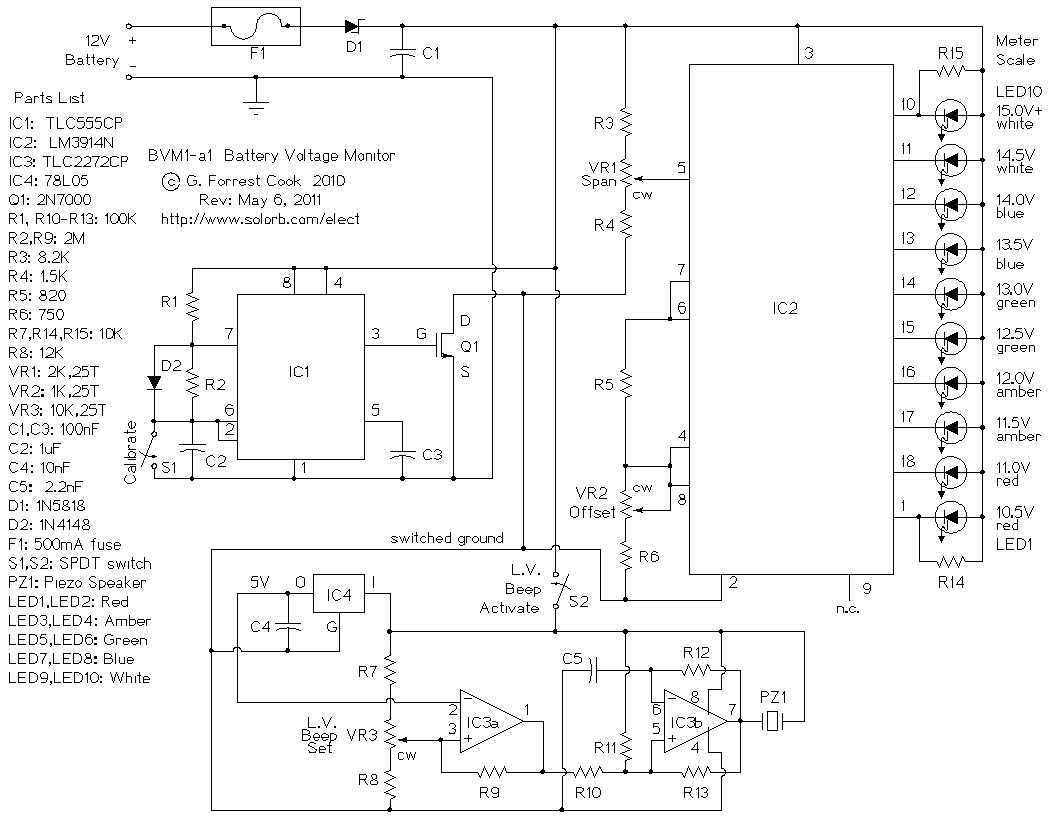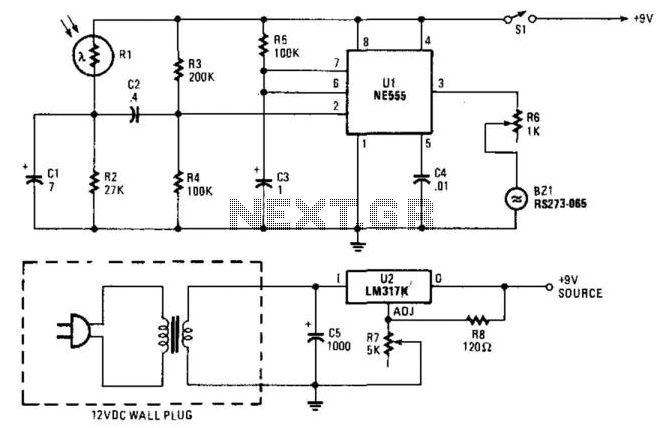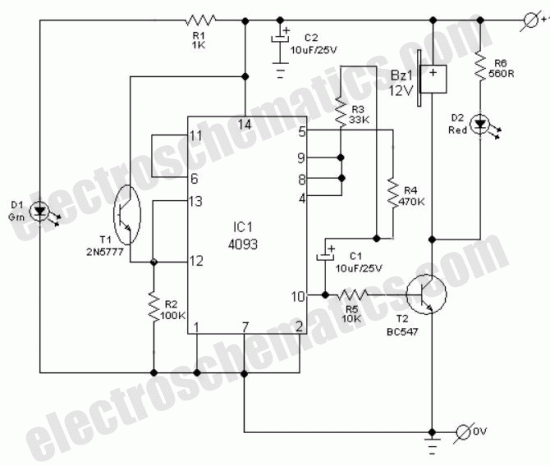
Timed Beeper

Beeps 7.5 seconds after a preset time. Adjustable time settings: 15 s, 30 s, 1 min, 2 min, and others. This circuit is intended for alerting purposes after a certain time is elapsed. It is suitable for table games requiring a fixed time to answer a question or to move a piece, etc. In this view, it is a modern substitute for the old sandglass. Useful also for time control when children are brushing teeth (at least two minutes!), or in the kitchen, and so on. More: Pushing on P1 resets IC2 that starts oscillating at a frequency fixed by R3 and C1. With values shown, this frequency is around 4Hz. LED D2, driven by IC1A and B, flashing at the same oscillator frequency, will signal proper circuit operation. SW1 selects.
The described circuit functions as a timer with adjustable settings, providing auditory alerts after a designated time interval. The core of the circuit is based on an integrated circuit (IC), specifically IC2, which is responsible for generating an oscillating signal. The oscillation frequency is determined by the resistor R3 and capacitor C1, which are selected to produce a frequency of approximately 4 Hz. This low frequency allows the circuit to beep at a manageable rate, suitable for the intended applications such as games or timed activities.
The user can adjust the timing settings to various intervals, including 15 seconds, 30 seconds, 1 minute, and 2 minutes, among others. This flexibility makes the circuit versatile for different scenarios, such as timing responses in games or monitoring activities like tooth brushing in children.
Activation of the timer is initiated by pressing switch P1, which resets IC2. Upon reset, IC2 begins to oscillate, thereby triggering the alert mechanism after the preset time elapses. The alert is signaled through an auditory beep, which serves as a notification for the user.
Additionally, LED D2 is incorporated into the circuit and is driven by operational amplifiers IC1A and IC1B. This LED blinks in sync with the oscillator frequency, providing a visual indication of circuit operation. The blinking LED not only confirms that the circuit is functioning correctly but also serves as an additional alert mechanism.
Switch SW1 allows the user to select between different timing modes, enhancing the usability of the circuit. This feature is particularly beneficial in environments where multiple timing intervals may be required, such as in cooking or during games.
Overall, the circuit provides a practical solution for timing applications, combining both auditory and visual alerts to effectively communicate the passage of time.Beeps 7.5 seconds after a preset time Adjustable time settings: 15 s. 30 s. 1 min. 2 min. & others This circuit is intended for alerting purposes after a certain time is elapsed. It is suitable for table games requiring a fixed time to answer a question, or to move a piece etc. In this view it is a modern substitute for the old sandglass. Useful also for time control when children are brushing teeth (at least two minutes!), or in the kitchen, and so on. Pushing on P1 resets IC2 that start oscillating at a frequency fixed by R3 & C1. With values shown, this frequency is around 4Hz. LED D2, driven by IC1A & B, flashing at the same oscillator frequency, will signal proper circuit operation. SW1 sele 🔗 External reference
The described circuit functions as a timer with adjustable settings, providing auditory alerts after a designated time interval. The core of the circuit is based on an integrated circuit (IC), specifically IC2, which is responsible for generating an oscillating signal. The oscillation frequency is determined by the resistor R3 and capacitor C1, which are selected to produce a frequency of approximately 4 Hz. This low frequency allows the circuit to beep at a manageable rate, suitable for the intended applications such as games or timed activities.
The user can adjust the timing settings to various intervals, including 15 seconds, 30 seconds, 1 minute, and 2 minutes, among others. This flexibility makes the circuit versatile for different scenarios, such as timing responses in games or monitoring activities like tooth brushing in children.
Activation of the timer is initiated by pressing switch P1, which resets IC2. Upon reset, IC2 begins to oscillate, thereby triggering the alert mechanism after the preset time elapses. The alert is signaled through an auditory beep, which serves as a notification for the user.
Additionally, LED D2 is incorporated into the circuit and is driven by operational amplifiers IC1A and IC1B. This LED blinks in sync with the oscillator frequency, providing a visual indication of circuit operation. The blinking LED not only confirms that the circuit is functioning correctly but also serves as an additional alert mechanism.
Switch SW1 allows the user to select between different timing modes, enhancing the usability of the circuit. This feature is particularly beneficial in environments where multiple timing intervals may be required, such as in cooking or during games.
Overall, the circuit provides a practical solution for timing applications, combining both auditory and visual alerts to effectively communicate the passage of time.Beeps 7.5 seconds after a preset time Adjustable time settings: 15 s. 30 s. 1 min. 2 min. & others This circuit is intended for alerting purposes after a certain time is elapsed. It is suitable for table games requiring a fixed time to answer a question, or to move a piece etc. In this view it is a modern substitute for the old sandglass. Useful also for time control when children are brushing teeth (at least two minutes!), or in the kitchen, and so on. Pushing on P1 resets IC2 that start oscillating at a frequency fixed by R3 & C1. With values shown, this frequency is around 4Hz. LED D2, driven by IC1A & B, flashing at the same oscillator frequency, will signal proper circuit operation. SW1 sele 🔗 External reference
